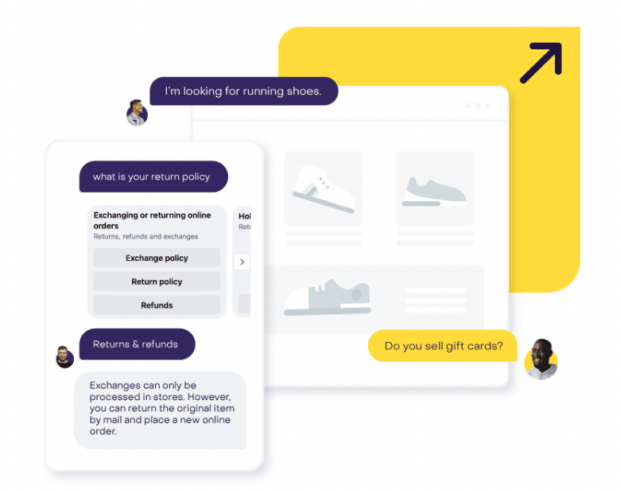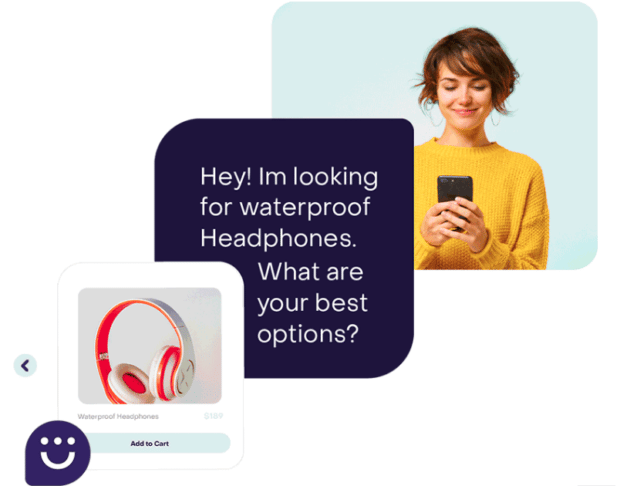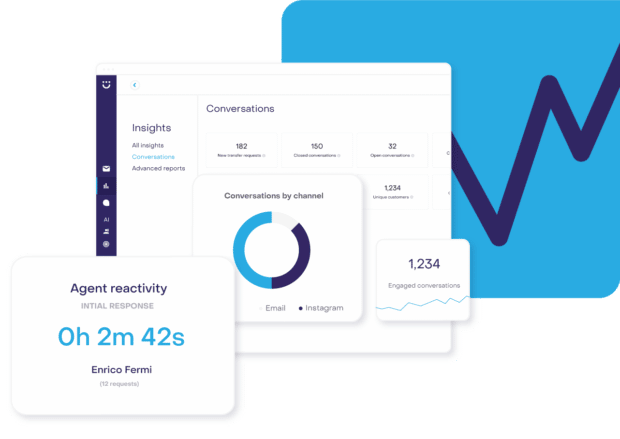Chatbot Analytics 101: Essential Metrics to Track
To get the most out of your chatbot, you need to dive into chatbot analytics. Implementing conversational AI can be a huge asset to your business. But to maximize your chatbot’s potential, you’ll need to measure its performance.
Of course, you already understand the importance of tracking key metrics for success. But we know it’s easy to get overwhelmed by the volume of data available. So what are the important metrics to measure?
In this post, we’ll break down the most important chatbot analytics for your business and how you can use them.
Bonus: Learn how to sell more products on social media with our free Social Commerce 101 guide. Delight your customers and improve conversion rates.
What are chatbot analytics?
Chatbot analytics is the conversational data generated by your chatbot’s interactions. Each time your chatbot connects with a customer, it gathers information. These data points can include conversation length, user satisfaction, number of users, conversational flow and more.
Why use chatbot analytics?
As with social media metrics, analytics show you how your chatbot is performing. This chatbot data can help you improve your business strategy in several ways:
Understand your customers’ needs better
Your chatbot is the first point of contact for customer questions. That means each conversation is a trove of data on their wants and needs. A chatbot uses natural language processing in real-time to communicate with your customers.
Analyzing this data will help you understand what they’re looking for, and how you can help them to find it.
Improve customer experience
Chatbot analytics can provide data on customer satisfaction. This is a straightforward measure of their experience dealing with your chatbot. You can use it to hone your chatbot strategy, improving the quality of service. And in the long term, you’ll keep your customers happy, so that they return to your business in the future.
Help your human team members work more efficiently
Every question that your chatbot answers is one less task for your human team. Customers and businesses exchange more than one billion messages on Facebook Messenger monthly! Save time on customer service by letting your chatbot pitch in.
Are your customers frequently escalating their chatbot questions to human agents? That shows there is room for improvement. Analytics will show you what frequently-asked questions your chatbot can learn to answer.
Enhance your product information
Chatbots are the first point of contact for customer questions. That gives you a ton of data on what customers find confusing. Do you see a lot of sizing questions? Time to improve your sizing info. Are your active users asking about product features? You might want to embed a demo video on your product page.
Boost sales
Chatbot analytics can tell you how many conversations end with a purchase. If it takes too long to get the answer they need, or if they get frustrated with the chatbot, they may bounce. Identifying areas for improvement will help you increase sales, along with customer satisfaction.
The 9 most important chatbot metrics to track
1. Average conversation length
This metric tells you how many messages your chatbot and customer are sending back and forth.
The ideal conversation length will vary: simple queries might be easier to resolve. Complex questions might take more back-and-forth. But the average conversation length will tell you how good your chatbot is at responding to their questions.
You’ll also want to take a look at the interaction rate, which shows how many messages are being exchanged. A high interaction rate shows your chatbot can hold a conversation.
2. Total number of conversations
This tells you how many times a customer opens the chatbot widget. This metric reveals how much demand there is for your chatbot. It can also help you determine when and where your customers initiate requests.
If you notice a pattern for when demand is higher, that information can also help you plan. Do customers start more conversations right after a new product release? Or on the first day of a sale? Anticipating these demands will help you ensure smooth customer service.
3. Total number of engaged conversations
“Engaged conversations” refers to interactions that continue after the welcome message. Comparing this metric to the number of total conversations will show you if your customers find the chatbot helpful.
Image from Heyday
4. Total number of unique users
This metric tells you how many people are interacting with your chatbot. A single customer might have several conversations with your chatbot during their journey. Comparing this metric to the total number of conversations will show you how many customers talk with your chatbot more than once.
5. Missed messages
This metric will tell you how often your chatbot was stumped by a customer question. Every time your chatbot says, “Sorry, I don’t understand,” that’s a missed message. These often result in a human takeover (more on that below). They can also lead to frustrated customers!
Missed messages provide important data on where you can improve your chatbot’s conversational skills. Ultimately, you can use this information to offer a better customer experience.
6. Human takeover rate
When your chatbot can’t resolve a customer query, it escalates the request to a human. This metric gives you a sense of how much time your chatbot is saving. Some conversational artificial intelligence (AI) users report up to 80% of customer questions are resolved by chatbots! It will also show you what kinds of customer needs require a human touch.
7. Goal completion rate
This rate shows you how often your chatbot helps you achieve your business goals. The outcomes will depend on your specific objectives.
For instance, is your chatbot supporting customers through the checkout process? Is it prompting them to add suggested items to their cart? The goal completion rate provides insight into how often your chatbot is meeting this target.
Image from Heyday
This rate also indicates how well your chatbot is guiding customers through their journeys. It’s sort of like a performance review for your most dedicated virtual employee.
8. Customer satisfaction scores
You can ask your customers to rate their experience with your chatbot after finishing a conversation. These satisfaction scores can be simple star ratings, or they can go into deeper detail. Regardless of your approach, satisfaction scores are important for refining your chatbot strategy. Looking at topics or issues where customers provide lower scores will show you where you can improve.
9. Average response time
Your chatbot will help your support team respond to live inquiries faster, by providing the first point of contact for customers. That will help you cut your average response time, increasing customer satisfaction. One company used Heyday to cut their average response time from 10 hours to 3.5! Plus, the information gathered by your chatbot can help your live support team provide the best possible answer to your customers.
What should I look for in a chatbot analytics dashboard?
To get the most out of your chatbot analytics, you need a dashboard that helps you see the most important metrics to track at a glance. Here are the most essential features to look for:
Easy to use
What good is data if you can’t find it? Your dashboard display should be simple and intuitive to navigate, so you can find the information you need. Here’s an example of a chatbot analytics dashboard from Heyday.
Heyday streamlines chatbot metrics into an easy-to-use dashboard.
Customization
Your business needs are unique, and so are your chatbot analytics. Look for a tool that lets you customize the display, so you can see the data that matters most to your business.
Multiple seats
Sharing a single login? What is this, Netflix? Look for a tool that gives each member of your customer support team a seat for seamless coordination. Got a big team? Don’t worry— some chatbot platforms like Heyday offer unlimited agent seats with enterprise plans.
Team performance tracking
Your chatbot is just one part of your customer service team. A valuable tool will also let you track your team’s performance, so you can evaluate your efforts as a whole.
Goal tracking
Performance data is only meaningful if it helps you reach your business goals. Otherwise, it’s like kicking a soccer ball around without a net— fun, but ultimately kind of pointless. You want a chatbot analytics dashboard that clearly displays how you’re meeting your business goals.
Mobile display
More than half of all online sales already happen on mobile devices. As social commerce rapidly grows, so does that figure. Customer support also happens on mobile, so make sure your tool works on screens of every size.
Customer FAQs
Looking at the most frequently asked questions is an incredible source of information about your customers. A dashboard that displays FAQs and analyzes them by content and theme will give you a deeper understanding of your audience.
Looking for a chatbot tool that can do all of this and more? Check out Heyday, a conversational AI tool from Hootsuite! With Heyday, you can increase your sales and customer satisfaction while saving time and money.
Turn customer service conversations into sales with Heyday. Improve response times and sell more products. See it in action.
Free DemoThe post Chatbot Analytics 101: Essential Metrics to Track appeared first on Social Media Marketing & Management Dashboard.
Categories
- 60% of the time… (1)
- A/B Testing (2)
- Ad placements (3)
- adops (4)
- adops vs sales (5)
- AdParlor 101 (43)
- adx (1)
- algorithm (1)
- Analysis (9)
- Apple (1)
- Audience (1)
- Augmented Reality (1)
- authenticity (1)
- Automation (1)
- Back to School (1)
- best practices (2)
- brand voice (1)
- branding (1)
- Build a Blog Community (12)
- Case Study (3)
- celebrate women (1)
- certification (1)
- Collections (1)
- Community (1)
- Conference News (1)
- conferences (1)
- content (1)
- content curation (1)
- content marketing (1)
- contests (1)
- Conversion Lift Test (1)
- Conversion testing (1)
- cost control (2)
- Creative (6)
- crisis (1)
- Curation (1)
- Custom Audience Targeting (4)
- Digital Advertising (2)
- Digital Marketing (6)
- DPA (1)
- Dynamic Ad Creative (1)
- dynamic product ads (1)
- E-Commerce (1)
- eCommerce (2)
- Ecosystem (1)
- email marketing (3)
- employee advocacy program (1)
- employee advocates (1)
- engineers (1)
- event marketing (1)
- event marketing strategy (1)
- events (1)
- Experiments (21)
- F8 (2)
- Facebook (64)
- Facebook Ad Split Testing (1)
- facebook ads (18)
- Facebook Ads How To (1)
- Facebook Advertising (30)
- Facebook Audience Network (1)
- Facebook Creative Platform Partners (1)
- facebook marketing (1)
- Facebook Marketing Partners (2)
- Facebook Optimizations (1)
- Facebook Posts (1)
- facebook stories (1)
- Facebook Updates (2)
- Facebook Video Ads (1)
- Facebook Watch (1)
- fbf (11)
- first impression takeover (5)
- fito (5)
- Fluent (1)
- Get Started With Wix Blog (1)
- Google (9)
- Google Ad Products (5)
- Google Analytics (1)
- Guest Post (1)
- Guides (32)
- Halloween (1)
- holiday marketing (1)
- Holiday Season Advertising (7)
- Holiday Shopping Season (4)
- Holiday Video Ads (1)
- holidays (4)
- Hootsuite How-To (3)
- Hootsuite Life (1)
- how to (5)
- How to get Instagram followers (1)
- How to get more Instagram followers (1)
- i don't understand a single thing he is or has been saying (1)
- if you need any proof that we're all just making it up (2)
- Incrementality (1)
- influencer marketing (1)
- Infographic (1)
- Instagram (39)
- Instagram Ads (11)
- Instagram advertising (8)
- Instagram best practices (1)
- Instagram followers (1)
- Instagram Partner (1)
- Instagram Stories (2)
- Instagram tips (1)
- Instagram Video Ads (2)
- invite (1)
- Landing Page (1)
- link shorteners (1)
- LinkedIn (22)
- LinkedIn Ads (2)
- LinkedIn Advertising (2)
- LinkedIn Stats (1)
- LinkedIn Targeting (5)
- Linkedin Usage (1)
- List (1)
- listening (2)
- Lists (3)
- Livestreaming (1)
- look no further than the new yorker store (2)
- lunch (1)
- Mac (1)
- macOS (1)
- Marketing to Millennials (2)
- mental health (1)
- metaverse (1)
- Mobile App Marketing (3)
- Monetizing Pinterest (2)
- Monetizing Social Media (2)
- Monthly Updates (10)
- Mothers Day (1)
- movies for social media managers (1)
- new releases (11)
- News (72)
- News & Events (13)
- no one knows what they're doing (2)
- OnlineShopping (2)
- or ari paparo (1)
- owly shortener (1)
- Paid Media (2)
- People-Based Marketing (3)
- performance marketing (5)
- Pinterest (34)
- Pinterest Ads (11)
- Pinterest Advertising (8)
- Pinterest how to (1)
- Pinterest Tag helper (5)
- Pinterest Targeting (6)
- platform health (1)
- Platform Updates (8)
- Press Release (2)
- product catalog (1)
- Productivity (10)
- Programmatic (3)
- quick work (1)
- Reddit (3)
- Reporting (1)
- Resources (34)
- ROI (1)
- rules (1)
- Seamless shopping (1)
- share of voice (1)
- Shoppable ads (4)
- Skills (28)
- SMB (1)
- SnapChat (28)
- SnapChat Ads (8)
- SnapChat Advertising (5)
- Social (169)
- social ads (1)
- Social Advertising (14)
- social customer service (1)
- Social Fresh Tips (1)
- Social Media (5)
- social media automation (1)
- social media content calendar (1)
- social media for events (1)
- social media management (2)
- Social Media Marketing (49)
- social media monitoring (1)
- Social Media News (4)
- social media statistics (1)
- social media tracking in google analytics (1)
- social media tutorial (2)
- Social Toolkit Podcast (1)
- Social Video (5)
- stories (1)
- Strategy (608)
- terms (1)
- Testing (2)
- there are times ive found myself talking to ari and even though none of the words he is using are new to me (1)
- they've done studies (1)
- this is also true of anytime i have to talk to developers (1)
- tiktok (8)
- tools (1)
- Topics & Trends (3)
- Trend (12)
- Twitter (15)
- Twitter Ads (5)
- Twitter Advertising (4)
- Uncategorised (9)
- Uncategorized (13)
- url shortener (1)
- url shorteners (1)
- vendor (2)
- video (10)
- Video Ads (7)
- Video Advertising (8)
- virtual conference (1)
- we're all just throwing mountains of shit at the wall and hoping the parts that stick don't smell too bad (2)
- web3 (1)
- where you can buy a baby onesie of a dog asking god for his testicles on it (2)
- yes i understand VAST and VPAID (1)
- yes that's the extent of the things i understand (1)
- YouTube (13)
- YouTube Ads (4)
- YouTube Advertising (9)
- YouTube Video Advertising (5)



